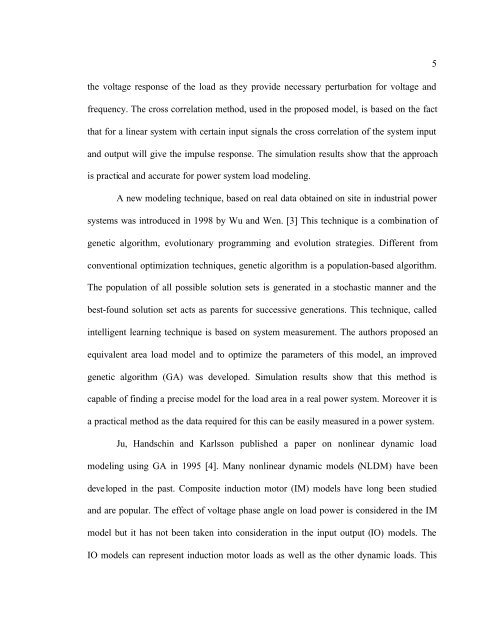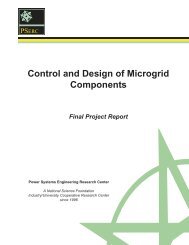symbolic dynamic models for highly varying power system loads
symbolic dynamic models for highly varying power system loads
symbolic dynamic models for highly varying power system loads
You also want an ePaper? Increase the reach of your titles
YUMPU automatically turns print PDFs into web optimized ePapers that Google loves.
5<br />
the voltage response of the load as they provide necessary perturbation <strong>for</strong> voltage and<br />
frequency. The cross correlation method, used in the proposed model, is based on the fact<br />
that <strong>for</strong> a linear <strong>system</strong> with certain input signals the cross correlation of the <strong>system</strong> input<br />
and output will give the impulse response. The simulation results show that the approach<br />
is practical and accurate <strong>for</strong> <strong>power</strong> <strong>system</strong> load modeling.<br />
A new modeling technique, based on real data obtained on site in industrial <strong>power</strong><br />
<strong>system</strong>s was introduced in 1998 by Wu and Wen. [3] This technique is a combination of<br />
genetic algorithm, evolutionary programming and evolution strategies. Different from<br />
conventional optimization techniques, genetic algorithm is a population-based algorithm.<br />
The population of all possible solution sets is generated in a stochastic manner and the<br />
best-found solution set acts as parents <strong>for</strong> successive generations. This technique, called<br />
intelligent learning technique is based on <strong>system</strong> measurement. The authors proposed an<br />
equivalent area load model and to optimize the parameters of this model, an improved<br />
genetic algorithm (GA) was developed. Simulation results show that this method is<br />
capable of finding a precise model <strong>for</strong> the load area in a real <strong>power</strong> <strong>system</strong>. Moreover it is<br />
a practical method as the data required <strong>for</strong> this can be easily measured in a <strong>power</strong> <strong>system</strong>.<br />
Ju, Handschin and Karlsson published a paper on nonlinear <strong>dynamic</strong> load<br />
modeling using GA in 1995 [4]. Many nonlinear <strong>dynamic</strong> <strong>models</strong> (NLDM) have been<br />
developed in the past. Composite induction motor (IM) <strong>models</strong> have long been studied<br />
and are popular. The effect of voltage phase angle on load <strong>power</strong> is considered in the IM<br />
model but it has not been taken into consideration in the input output (IO) <strong>models</strong>. The<br />
IO <strong>models</strong> can represent induction motor <strong>loads</strong> as well as the other <strong>dynamic</strong> <strong>loads</strong>. This
















